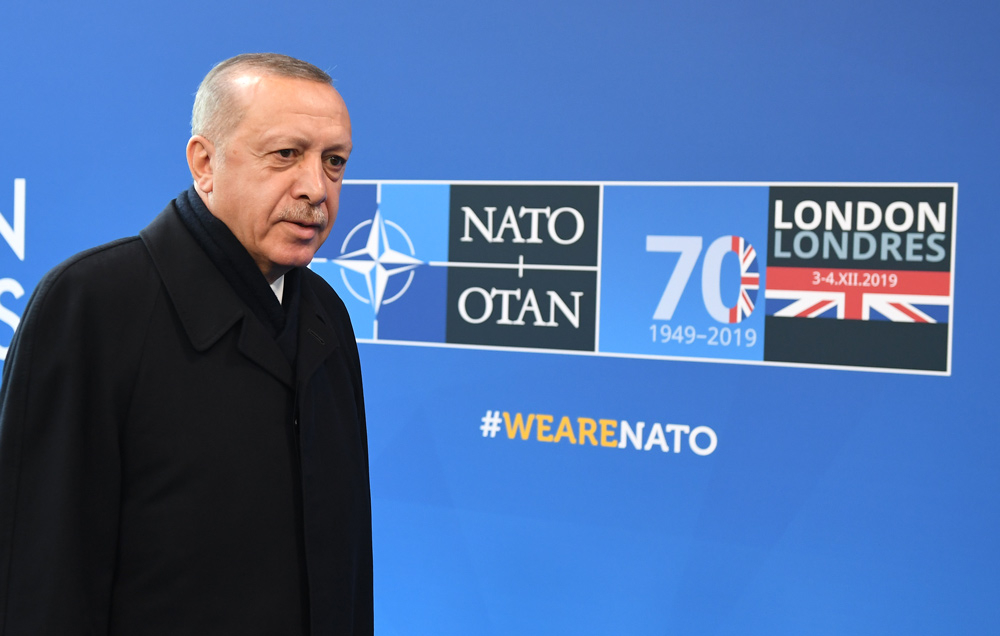 Prezydent Turcji Recep Tayyip Erdoğan próbuje zmienić to, co wydaje się być jednym z ważniejszych strategicznych posunięć w historii NATO, w handel dywanami na Wielkim Bazarze w Stambule. Na zdjęciu: Erdoğan przybywa na szczyt NATO w Watford w Anglii 4 grudnia 2019 r.
Prezydent Turcji Recep Tayyip Erdoğan próbuje zmienić to, co wydaje się być jednym z ważniejszych strategicznych posunięć w historii NATO, w handel dywanami na Wielkim Bazarze w Stambule. Na zdjęciu: Erdoğan przybywa na szczyt NATO w Watford w Anglii 4 grudnia 2019 r.

Dlaczego Erdoğan szantażuje NATO?
Burak Bekdil Tłumaczenie: Małgorzata Koraszewska
Po raz kolejny Turcja jest odstającym elementem w sojuszu NATO. Islamski autokrata, prezydent Recep Tayyip Erdoğan, próbuje zmienić to, co wydaje się być jednym z ważniejszych strategicznych posunięć w historii NATO, w handel dywanami na Wielkim Bazarze w Stambule.
Erdoğan powiedział 13 maja, że jego kraj “nie przychyla się” do idei przystąpienia Finlandii i Szwecji do NATO, dając do zrozumienia, że Turcja może wykorzystać swoje członkostwo w zachodnim sojuszu wojskowym do zawetowania decyzji o przyjęciu tych dwóch krajów.
Erdoğan wyjaśnił swój sprzeciw, powołując się na domniemane wsparcie Szwecji i innych krajów skandynawskich dla bojowników kurdyjskich i innych, których Turcja uważa za terrorystów. Tego potępienia nie można traktować poważnie. Erdoğan ma zwyczaj nazywania terrorystą każdego, kto różni się od niego politycznie i religijnie.
W ciągu ostatnich kilku lat na starannie wyselekcjonowanej liście terrorystów Erdoğana znaleźli się tureccy obywatele, którzy zainwestowali w dolary amerykańskie, zagraniczne agencje ratingowe, partie opozycyjne, gminy zarządzane przez partie opozycyjne, główny przywódca opozycji Kemal Kılıçdaroğlu, Turcy głosujący inaczej niż on chciał, kurdyjscy politycy i dziennikarze. W lutym 2021 roku oskarżył demonstrujących studentów o terroryzm, kiedy turecka policja aresztowała ich za protestowanie przeciwko nominowanemu przez Erdoğana nowemu rektorowi na jednym z najlepszych uniwersytetów w kraju.
W ciągu roku po wyborach samorządowych w marcu 2019 roku burmistrzowie zostali zastąpieni przez powierników w ponad połowie z około 65 gmin, w których wygrała prokurdyjska partia HDP, a kilku z burmistrzów zostało aresztowanych pod zarzutem powiązań terrorystycznych. Rząd Erdoğana mianował powierników jako gubernatorów i inne władze lokalne w tych okręgach.
Dziś wiarygodne sondaże opinii publicznej oceniają, że popularność bloku opozycyjnego jest znacznie wyższa od popularności Erdoğana. Według ORC Research, gdyby dziś odbyły się wybory, Partia Sprawiedliwości i Rozwoju (AKP) Erdoğana zdobyłaby 28 % głosów, w porównaniu z łączną liczbą głosów 42,5% dla dwóch głównych partii opozycyjnych. W świecie Erdoğana oznacza to, że dwie trzecie Turków (około 56 milionów) jest terrorystami.
Z wyjątkiem sześciomiesięcznego okresu “rozziewu”, kiedy Turcja zestrzeliła rosyjski myśliwiec Su-24 przy granicy z Syrią w listopadzie 2015 roku, Erdoğan przez ostatnie dwadzieścia lat był “człowiekiem prezydenta Rosji Władimira Putina” w NATO.
Teraz, kiedy Erdoğan szantażuje NATO, ponieważ potencjalni przyszli członkowie, Szwecja i Finlandia, “wspierają kurdyjskich terrorystów”, zobaczmy, co robią w tej sprawie jego przyjaciele w Moskwie.
Kurdyjską organizacją bojową, która walczy z Turcją od 1984 roku, jest Partia Pracujących Kurdystanu, w skrócie PKK. PKK znajduje się na liście organizacji terrorystycznych Turcji, Unii Europejskiej i Stanów Zjednoczonych. Turcja walczy również z YPG, kurdyjskim akronimem Powszechnych Jednostek Ochrony, potomstwa PKK w północnej Syrii. A co z Rosją? Rosja nie uznaje ani PKK, ani YPG za podmioty terrorystyczne. I to nie przeszkadza Erdoğanowi.
Według Michaela A. Reynoldsa:
“Związek rosyjsko-kurdyjski jest powracającym elementem geopolityki Bliskiego Wschodu od ponad dwustu lat, odkąd Katarzyna Wielka zleciła publikację gramatyki kurdyjskiej w 1787 roku. Zainteresowanie Katarzyny Kurdami nie było czysto akademickie. Carscy urzędnicy uznali, że plemiona kurdyjskie są ważnymi aktorami wzdłuż południowych granic Rosji. Od 1804 roku Kurdowie odgrywali ważną rolę w wojnach Rosji z Persją Kadżarów i Turcją Osmanów. W miarę upływu stulecia armia rosyjska coraz częściej wykorzystywała jednostki kurdyjskie do walki z Persami i Turkami “.
Wszystko to powtarza się w dzisiejszej Rosji Putina. W 2016 roku Erdoğan oskarżył Rosję o dostarczanie bojownikom PKK broni przeciwlotniczej i rakiet. W 2020 roku tureckie Ministerstwo Spraw Zagranicznych oficjalnie potępiło Rosję za zapraszanie i prowadzenie rozmów z delegacją YPG – czyli czerwony dywan dla “terrorystów” Erdoğana. Minister spraw zagranicznych Rosji Siergiej Ławrow spotkał się w listopadzie 2021 roku z inną delegacją YPG w Moskwie. Więcej czerwonych dywanów dla “terrorystów”.
Żaden z przykładów rosyjskiego życzliwego traktowania tureckich “terrorystów kurdyjskich” nie jest tajemnicą. Rosja otwarcie robi wszystko, co w jej mocy, dla swoich kurdyjskich przyjaciół, a Erdoğan zachowuje całkowite milczenie. Teraz ten sam Erdoğan szantażuje NATO, wetując członkostwo dwóch krajów Europy Zachodniej na tej podstawie, że te kraje, zagrożone przez Rosję, wspierają kurdyjskich terrorystów.
Zachodni sojusz wojskowy powinien być wystarczająco silny, aby powiedzieć Erdoğanowi to, co musi usłyszeć.
Zawartość publikowanych artykułów i materiałów nie reprezentuje poglądów ani opinii Reunion’68,
ani też webmastera Blogu Reunion’68, chyba ze jest to wyraźnie zaznaczone.
Twoje uwagi, linki, własne artykuły lub wiadomości prześlij na adres:
webmaster@reunion68.com






